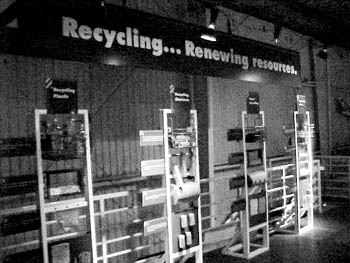![[Metroactive Features]](/features/gifs/feat468.gif)
[ Features Index | Silicon Valley | Metroactive Home | Archives ]
Garbage Museum
By
DID YOU KNOW that in 1882, pigs were turned loose on the streets of New York City to eat the garbage? Or that the first garbage dumps were invented by the Greeks in 500 B.C.E.? Or that each recycled glass bottle saves enough energy to light a 100-watt bulb for four hours? Or that the amount of garbage the United States produces every day would fill 63,000 garbage trucks, which, if lined up end to end, would stretch from San Francisco to L.A.? These are only some of the trivial facts posted on placards adorning the spectacular 100-foot-long Wall of Garbage inside the Garbage Museum.
[UPDATE: The interactive Wall of Garbage tour is no longer available at the Newby Island Landfill.]
Just west of 880 in Milpitas sits a integrated solid-waste facility known as the Newby Island Landfill, spanning 342 acres. And at this landfill, you'll find Browning Ferris Industry's recyclery, the centerpiece of which is the Education Center, a.k.a. the Garbage Museum. Various interactive displays illustrate the recycling process and the problems caused by solid waste. The massive Wall of Garbage represents just three minutes' worth of Santa Clara County's refuse.
Just a quick trip up the stairs in the building across the walkway leads to an observation deck where visitors can view the $10 million state-of-the-art Materials Recovery Facility (MRF), spanning 80,000 square feet, making it one of the largest of its kind in the world. Yes, this is where the garbage trucks go after they pick up the recyclables from your curb, if you remembered to put them out the night before. Up to 1,600 tons of garbage can be accommodated here. The trucks back in and dump garbage onto a massive sorting floor, where large items are removed. In a bizarre form of Orwellian video surveillance, you can even watch the remainders pushed on a conveyer belt through a closed room where employees pick out plastic bottles, metals, glass and other recyclables. What a job. "The employees work in two shifts, one in the morning and one in the afternoon," explains Lori Peace, the recycling tour coordinator of the museum, who leads hour-long educational tours of the facility and the observation deck.
Children often visit the museum on field trips, and B.F.I. created its Mobius Program to help children become better environmental citizens by learning the importance of an integrated waste management and recycling system. The Mobius Mascot, a life-size character made up of empty bottles, pull tabs from soda cans and other major recycling elements, greets kids at the entrance of the garbage museum, kind of like Mickey Mouse at Disneyland.
Inside, visitors can explore the exhibits, answer garbage trivia questions and interact with displays that showcase the processes by which glass, papers, metals and plastics are broken down, chemically treated and recycled for future use. Need a pallet of compost? This is the place. The museum preaches the three R's: Reduce, Reuse and Recycle.
Tours are available for Santa Clara County residents on Mondays and Wednesdays, and for Alameda County residents on Tuesdays, Thursdays and Fridays. The tours are free, but a minimum of eight people is required for booking. If you want to check out the landfill itself, go for it. There just nothing like watching thousands of sea gulls hover about while bulldozers roll over the refuse. For connoisseurs of trash, this place is the bomb.
Built on top of a 300-foot-thick layer of clay dating back to ancient times, the Newby Island Landfill is the result of millennia of storm runoff from the bay and is currently at 78 percent of its capacity. By 2020 it will reach critical mass. After that, plans are to make it an open-space wildlife preserve for at least 30 years. The snowy egrets and blue herons who fly in from the nearby wildlife preserves have already anticipated that halcyon day.
Favorite Local Collections
Rite of Pez-age: The Museum of Pez Memorabilia in Burlingame.
The Hole Truth: Lou's Living Donut Museum in San Jose.
Composing a Life: The Ira F. Brilliant Center for Beethoven Studies at San Jose State University.
Waste Not: The Garbage Museum in Milpitas.
Lofty Ambitions: The Wings of History Museum in San Martin.
High-Tech Hit Parade: The Intel Museum in Santa Clara.
History Lesson: The Japanese-American Museum of San Jose.
Beyond the Doily: The Lace Museum in Sunnyvale.
Museums: A complete guide to local museums.
[ Silicon Valley | Metroactive Home | Archives ]
Copyright © Metro Publishing Inc. Metroactive is affiliated with the Boulevards Network.
For more information about the San Jose/Silicon Valley area, visit sanjose.com.
![]()

Waste Not
Garbage Museum Hours: Mon-Sat, 8am-5pm. Admission: Free. BFI Recyclery,
Newby Island Landfill, 1601 Dixon Landing Rd., Milpitas; 408.262.1401
Send a letter to the editor about this story to letters@metronews.com.
From the March 13-19, 2003 issue of Metro, Silicon Valley's Weekly Newspaper.